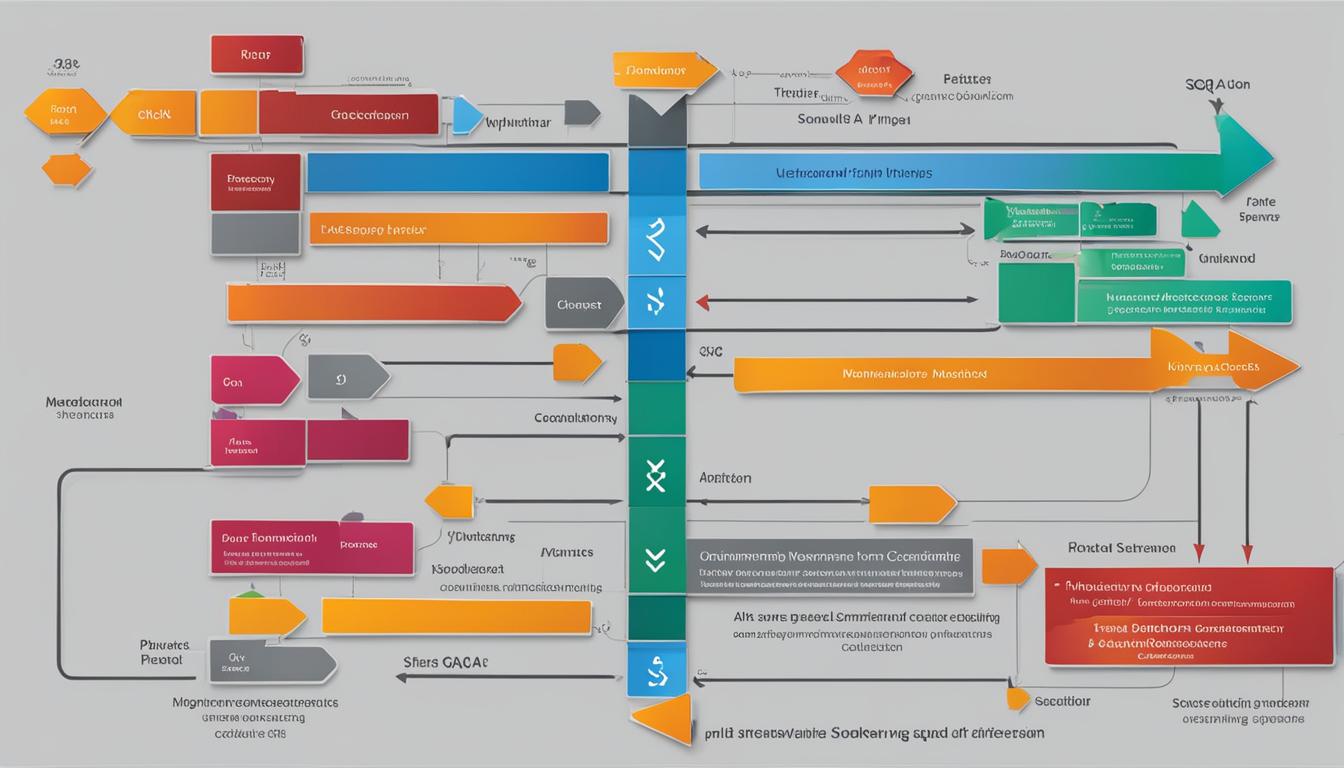In the software development life cycle (SDLC), Software Quality Assurance (SQA) plays a critical role. It is an essential component for development teams dedicated to providing top-notch software products. By implementing SQA methodologies, companies can maintain steady quality control during the SDLC and minimize risks.
SQA encompasses various techniques and practices that focus on software testing and quality assurance. It involves meticulous testing processes, meticulous code inspection, and the application of standardized software quality metrics to measure and track the quality of the software. Successful SQA implementation requires the adoption of best practices and effective software quality management techniques.
Key Takeaways:
- SQA ensures that software products comply with quality standards throughout the SDLC.
- It involves rigorous testing, code inspection, and the use of software quality metrics.
- SQA techniques and best practices play a vital role in mitigating risks and ensuring software quality.
- Effective SQA implementation requires structured processes and constant improvement.
- Software quality management is an integral part of SQA, encompassing planning, monitoring, and improvement activities.
What is Software Quality Assurance?
Software quality assurance (SQA) is a methodology used to ensure that software products meet a predetermined set of quality standards. As an integral part of the software development life cycle (SDLC), SQA functions in parallel with the development process to identify and address issues before they become major problems. It evaluates both internal and external characteristics of the software, including efficiency, reliability, structure, flexibility, testability, and coding practices, among others.
By implementing SQA, businesses can ensure that their software products adhere to the highest quality standards and meet the expectations and needs of their customers. Whether it’s improving the efficiency of the software, enhancing its reliability, or ensuring proper coding practices, SQA plays a vital role in delivering high-quality software products.
SQA employs various techniques and methodologies to assess the quality of the software at different stages of the SDLC. These include conducting reviews, performing testing, and monitoring and measuring software quality. By following these rigorous SQA practices, organizations can identify potential issues, mitigate risks, and ultimately produce software products that satisfy the requirements and demands of their target audience.
Implementing SQA allows businesses to deliver software products that meet the highest quality standards and fulfill the expectations of their customers.
As we delve deeper into this article, we will explore the purpose, principles, implementation, and benefits of software quality assurance. Additionally, we will discuss different approaches to SQA, various SQA techniques, and static analysis, along with its importance in ensuring software quality and security.

Internal and External Characteristics Evaluated by Software Quality Assurance
| Internal Characteristics | External Characteristics |
|---|---|
| Efficiency | Reliability |
| Structure | Flexibility |
| Testability | Coding Practices |
The Purpose of Software Quality Assurance
Software quality assurance (SQA) serves a crucial purpose in the software development life cycle (SDLC). It operates alongside the development process, ensuring that all aspects of the software, both internally and externally, adhere to pre-established quality standards. By evaluating software efficiency, reliability, and maintenance costs, SQA plays a vital role in delivering high-quality products that meet customer expectations.
Internally, SQA focuses on the internal characteristics of the software, including its structure, complexity, readability, flexibility, testability, and coding practices. By conducting SQA tests at each stage of the SDLC, businesses can identify and address potential issues early on, preventing them from becoming significant problems in the future. This proactive approach helps organizations save time and resources by minimizing the need for extensive rework or maintenance.
Externally, SQA ensures that the software meets the criteria established by software quality standards. These standards encompass various aspects, such as usability, performance, security, and compliance. By aligning the software with these standards, organizations can enhance the user experience, protect data, and achieve regulatory compliance.
Furthermore, SQA plays a crucial role in evaluating software efficiency, reliability, and maintenance costs. It ensures that the software operates efficiently, utilizing system resources effectively and responding promptly to user inputs. SQA also focuses on software reliability, aiming to minimize the occurrence of errors, crashes, or malfunctions. By conducting thorough testing and inspections, SQA aims to identify and address software defects that could lead to higher maintenance costs in the long run.
In conclusion, the purpose of software quality assurance is to guarantee that every aspect of the software, both internal and external, adheres to predefined quality standards. By evaluating software efficiency, reliability, and maintenance costs, SQA enables organizations to deliver high-quality products that meet customer expectations, comply with regulations, and operate efficiently while minimizing maintenance costs.
| Internal Characteristics | External Characteristics |
|---|---|
| Structure | Usability |
| Complexity | Performance |
| Readability | Security |
| Flexibility | Compliance |
| Testability | |
| Coding practices |
Principles of Software Quality Assurance
To implement software quality assurance (SQA) effectively, we follow certain principles that ensure efficient SQA practices and deliver high-quality software products. These principles encompass defect prevention, continuous improvement, stakeholder involvement, and a risk-based approach.
Defect Prevention
Defect prevention is a fundamental principle of SQA. It emphasizes the importance of identifying and addressing potential issues early in the software development life cycle (SDLC). By proactively addressing defects, we can minimize the occurrence of problems and improve the overall quality of the software product.
Continuous Improvement
Continuous improvement is an essential principle in SQA. We integrate SQA into the development process, consistently monitoring and improving software quality. By continuously enhancing our SQA practices, we can adapt to changing requirements, technologies, and customer expectations, ensuring that our software products meet the highest standards.
Stakeholder Involvement
Stakeholder involvement is crucial in SQA. We believe in collaborating with all stakeholders throughout the software development process. By involving customers, developers, testers, and other relevant parties, we can foster effective communication, gain valuable insights, and ensure that the software product meets their expectations and needs.
Risk-based Approach
A risk-based approach is a key principle in SQA. We focus on identifying and addressing the most significant risks in the software product. By prioritizing and mitigating potential risks, we can minimize the impact on software quality and address critical issues that could affect the overall success of the project.
By following these principles, we uphold the highest standards of software quality assurance, delivering exceptional software products that meet customer expectations and drive business success.
How to Implement Software Quality Assurance
To implement software quality assurance (SQA) effectively, we need to follow a structured approach that encompasses several essential steps:
- Defining Quality Standards: We must clearly specify the quality standards in terms of requirements, acceptance criteria, and performance metrics agreed upon by all stakeholders. This ensures a shared understanding of what constitutes high-quality software.
- Planning SQA Activities: Developing a comprehensive plan for SQA activities is crucial. This involves defining the scope of reviews, testing, and documentation, as well as specifying responsibilities and timelines.
- Conducting Reviews: Reviews play a vital role in identifying defects at an early stage. It is essential to involve experts who are not directly involved in development to ensure unbiased evaluations.
- Performing Testing: Testing is a critical component of SQA. It should encompass various types of testing, including unit testing, integration testing, system testing, and acceptance testing. Each type of testing serves a specific purpose in ensuring the overall quality of the software.
- Monitoring and Measuring Software Quality: Continuously monitoring and measuring software quality allows us to track defects, analyze relevant metrics, and conduct root cause analysis. This provides valuable insights into the effectiveness of our SQA efforts.
- Continuous Improvement: Finally, we must prioritize continuous improvement in the SQA process. By leveraging insights gained from monitoring and measuring software quality, we can identify areas for improvement and implement necessary changes to enhance the overall quality of our software products.
Implementing SQA in a structured manner ensures that our software products meet the highest quality standards and fulfill customer expectations. It allows us to proactively address potential issues, minimize risks, and deliver software that stands the test of time.

Different Approaches to Software Quality Assurance
When it comes to software quality assurance (SQA), organizations have various approaches to choose from based on their software development process. Each approach offers unique benefits and is tailored to specific requirements. Let’s explore some of the popular software quality assurance approaches:
- Traditional Approach: Also known as the Waterfall model, this approach follows a sequential process where each phase of the software development life cycle (SDLC) is completed before moving on to the next phase. SQA is performed at the end of each phase to ensure that all requirements have been met.
- Agile Approach: The Agile approach takes an iterative and incremental approach to software development. It focuses on delivering software products in small increments or sprints, encouraging collaboration, flexibility, and continuous improvement throughout the development process.
- DevOps Approach: The DevOps approach combines development (Dev) and IT operations (Ops) to ensure seamless collaboration and faster delivery of software. It emphasizes automation, continuous integration, and continuous deployment to meet customer requirements effectively.
- Six Sigma Approach: The Six Sigma approach focuses on reducing defects and errors in software products. It utilizes statistical tools and techniques to identify and eliminate variations in the development process, resulting in improved software quality.
- Lean Approach: The Lean approach aims to enhance efficiency and reduce waste throughout the software development process. It focuses on delivering value to customers by eliminating non-essential activities and streamlining workflows.
- Continuous Integration and Continuous Deployment (CI/CD) Approach: The CI/CD approach emphasizes continuous integration and deployment of software. It involves automating the testing and deployment process, enabling faster and more frequent releases while maintaining high quality.
- Test-Driven Development (TDD) Approach: The TDD approach involves writing automated tests before writing the code. It promotes a systematic approach to development, ensuring that software features are thoroughly tested and validated throughout the development process.
Each approach to software quality assurance brings its own advantages and is suitable for different project requirements. By choosing the most appropriate approach, organizations can effectively ensure high software quality throughout the development life cycle.

Static Analysis for Software Quality Assurance
Static analysis is a crucial method used in software quality assurance (SQA) to evaluate software artifacts and identify potential issues. It plays a significant role in ensuring the overall quality of software products. By analyzing the code’s structure, syntax, semantics, and relationships between components, static analysis helps in identifying vulnerabilities, bugs, and defects that may compromise the software’s functionality and reliability.
There are two primary approaches to performing static analysis: manual analysis and automated analysis using specialized tools. Manual analysis involves human experts manually examining the code for potential issues. While this approach can be effective, it can also be time-consuming and prone to human error. To streamline the process and improve efficiency, many organizations rely on automated static analysis tools.
Two popular static analysis tools commonly used by development teams are Sonarqube and Code Climate.
Sonarqube is an open-source platform that provides continuous code quality inspection. It supports multiple programming languages and offers a wide range of features to analyze code quality, identify bugs, enforce coding standards, and detect security vulnerabilities. By integrating Sonarqube into the development workflow, developers can receive instant feedback on code quality and address any issues early in the development process.
Code Climate, on the other hand, is a cloud-based platform that offers automated code reviews for various programming languages. It provides detailed insights into code quality, highlights potential issues, and offers actionable recommendations for improvement. Code Climate’s user-friendly interface and extensive integrations with popular development tools make it a valuable asset for development teams looking to enhance code quality and maintainability.
By leveraging static analysis tools like Sonarqube and Code Climate, development teams can significantly improve the quality of their software products. These tools not only help identify potential issues but also provide actionable recommendations to address them, ultimately leading to more robust and reliable software.
To summarize, static analysis is an essential technique in software quality assurance that enables development teams to identify and address potential issues early in the software development lifecycle. By utilizing powerful static analysis tools like Sonarqube and Code Climate, organizations can ensure the delivery of high-quality software products that meet customer expectations and industry standards.
Benefits of Software Quality Assurance
Implementing software quality assurance (SQA) brings several benefits to organizations. Let’s explore how SQA can positively impact your business.
Cost Savings
By implementing SQA practices, businesses can save costs in the long run. Detecting and addressing issues early in the development process helps prevent costly fixes later on. This proactive approach reduces the need for extensive rework and minimizes the impact on project timelines and budgets.
Reputation Management
SQA plays a crucial role in managing and maintaining your organization’s reputation. By delivering high-quality software products that meet customer expectations, you enhance trust and credibility. Satisfied customers are more likely to recommend your brand to others, contributing to positive word-of-mouth referrals and fostering a strong reputation in the market.
Customer Loyalty
High software quality achieved through SQA efforts leads to increased customer loyalty and satisfaction. When customers consistently receive reliable, bug-free software products, they develop trust in your brand. This fosters long-term relationships and encourages repeat business, ultimately driving revenue growth.
Improved Productivity
SQA provides a stable and reliable software environment for your team. This enables employees to work efficiently, without disruptions caused by software defects or errors. With reliable software, your team can focus on their core tasks, leading to improved productivity and streamlined workflows.
Enhanced Security
Security threats are a major concern in today’s digital landscape. By incorporating SQA practices, you can identify and address vulnerabilities in your software, reducing the risk of attacks. This proactive approach to security helps safeguard your organization’s sensitive data and protects your customers’ information.
Overall, implementing software quality assurance (SQA) ensures that your organization is delivering high-quality software products, resulting in cost savings, reputation management, customer loyalty, improved productivity, and enhanced security. Investing in SQA is an investment in the success of your business.
Conclusion
Software quality assurance (SQA) is an essential component of the software development life cycle (SDLC) that ensures software products meet the highest quality standards and satisfy customer expectations. By implementing SQA, organizations can follow key principles like defect prevention and continuous improvement, adopting structured approaches to planning, testing, and improvement.
SQA techniques, including auditing, code inspection, and static analysis, play a pivotal role in identifying and addressing issues early in the development process. These techniques enable businesses to mitigate risks and improve the overall quality of their software products.
Implementing SQA brings numerous benefits, such as cost savings through early issue detection, enhanced reputation and customer loyalty, improved productivity, and heightened software security. By prioritizing SQA, organizations can deliver high-quality software, drive business success, and ensure the satisfaction of both customers and stakeholders.
FAQ
What is Software Quality Assurance?
Software Quality Assurance (SQA) is a methodology to ensure that the quality of the software product complies with a predetermined set of standards. It is an integral part of the software development life cycle (SDLC) and functions in parallel with the development process. SQA tests every block of the SDLC individually to identify and address issues before they become major problems. It evaluates both internal and external characteristics of the software, including efficiency, reliability, structure, flexibility, testability, and coding practices. By implementing SQA, businesses can ensure that their software products meet the highest quality standards and fulfill the expectations and needs of customers.
What is the purpose of Software Quality Assurance?
The purpose of software quality assurance (SQA) goes beyond just a step in the development process. It functions in parallel with the software development life cycle (SDLC) to ensure that every part of the software, both internal and external, meets the predefined quality standards. SQA evaluates the efficiency, reliability, and maintenance cost of the software. Internally, it focuses on the structure, complexity, readability, flexibility, testability, and coding practices followed by developers. By conducting SQA tests at every stage of the SDLC, businesses can identify and address any potential issues early on, preventing them from becoming major problems later.
What are the principles of Software Quality Assurance?
To implement software quality assurance (SQA) effectively, certain principles need to be followed. These principles ensure that SQA is conducted efficiently and that the software product meets the highest quality standards. The principles include defect prevention, emphasizing the importance of identifying and addressing potential issues early in the SDLC; continuous improvement, integrating SQA into the development process and consistently monitoring and improving software quality; stakeholder involvement, involving all stakeholders in the software development process to ensure collaboration and communication; and a risk-based approach, focusing on identifying and addressing the most significant risks in the software product. Following these principles helps businesses deliver high-quality software products that meet customer expectations.
How do you implement Software Quality Assurance?
To implement software quality assurance (SQA) effectively, a structured approach is necessary. This approach involves several steps, including defining quality standards, planning SQA activities, conducting reviews, performing testing, monitoring and measuring software quality, and continuously improving the SQA process. Defining quality standards requires clearly specifying requirements, acceptance criteria, and performance metrics agreed upon by all stakeholders. Planning SQA activities involves developing a plan for reviews, testing, and documentation, specifying responsibilities and timelines. Reviews should be conducted by experts not directly involved in development to identify defects early. Testing should include various types such as unit testing, integration testing, system testing, and acceptance testing. Monitoring and measuring software quality involves tracking defects, analyzing metrics, and conducting root cause analysis. Continuous improvement is essential, using the results to identify areas for improvement and implement changes to the SQA process.
What are the different approaches to Software Quality Assurance?
There are different approaches to software quality assurance (SQA) that organizations can use based on their software development process. The traditional approach, also known as the Waterfall model, involves a sequential process where each phase of the SDLC is completed before moving on to the next phase. SQA is performed at the end of each phase to ensure requirements have been met. The Agile approach is iterative and focuses on delivering software products in small increments, emphasizing collaboration and continuous improvement. The DevOps approach combines development and IT operations to ensure customer requirements are met, using collaboration, automation, and continuous delivery. The Six Sigma approach focuses on reducing defects and errors using statistical tools and techniques. The Lean approach emphasizes efficiency and waste reduction. The CI/CD approach focuses on continuous integration and deployment. The TDD approach involves testing throughout the development process.
Why is Software Quality Assurance important?
Software quality assurance (SQA) is crucial for several reasons. It ensures customer satisfaction by delivering high-quality software products that meet their expectations and needs. It helps organizations comply with industry standards and regulations, enhancing trust and credibility. SQA contributes to the scalability and maintainability of software systems, making them easier to modify and extend as business requirements evolve. It improves software security by identifying and addressing vulnerabilities and reducing the risk of attacks. By implementing SQA practices, organizations can save time and costs by maintaining easily maintainable and modifiable code. Additionally, SQA improves the overall reputation of the organization and increases customer loyalty.
What are the techniques used in Software Quality Assurance?
There are various techniques and methods used in software quality assurance (SQA) to ensure high-quality software. Some of these techniques include auditing, which involves inspecting work products and information related to them to assess compliance with standard processes; reviewing, which is a meeting where the software product is evaluated by stakeholders to provide comments and approval; code inspection, a formal review process to find bugs and defects; static analysis, which analyzes the structure, syntax, and semantics of the code to identify issues; walkthroughs, where the developer guides the development team through the product to raise queries and suggest improvements; unit testing, which ensures complete code coverage by executing each independent path and condition; and stress testing, which evaluates the system’s robustness under heavy load or stress conditions.
What is static analysis in Software Quality Assurance?
Static analysis is a method used in software quality assurance (SQA) to evaluate software artifacts and identify potential issues. It focuses on analyzing the code structure, syntax, semantics, and relationships between components to find vulnerabilities, bugs, and defects. Static analysis can be performed manually or with the help of automated tools designed specifically for static analysis. Two popular tools for static analysis are Sonarqube and Code Climate. Sonarqube is an open-source platform that offers continuous code quality inspection and supports multiple programming languages. Code Climate is a cloud-based platform that provides automated code reviews for various programming languages. These tools help developers improve code quality and prevent issues that could affect the software’s maintainability and reliability.
What are the benefits of Software Quality Assurance?
Implementing software quality assurance (SQA) brings several benefits to organizations. It saves costs by preventing and addressing issues early in the development process, reducing the need for costly fixes later on. SQA helps manage and maintain the organization’s reputation by delivering high-quality software products that meet customer expectations. This, in turn, increases customer loyalty and satisfaction. SQA improves productivity by providing a stable and reliable software environment that allows employees to work efficiently. It also enhances security by identifying and addressing vulnerabilities, reducing the risk of attacks. Overall, SQA helps organizations deliver better software and achieve their business objectives.









